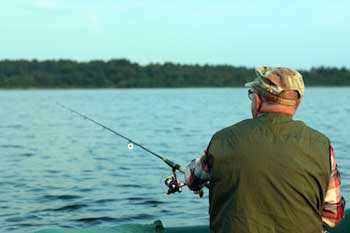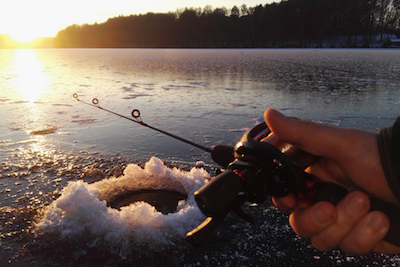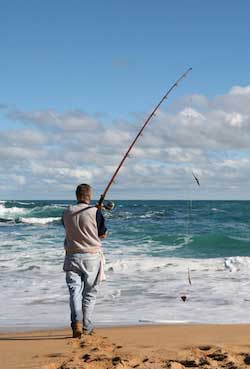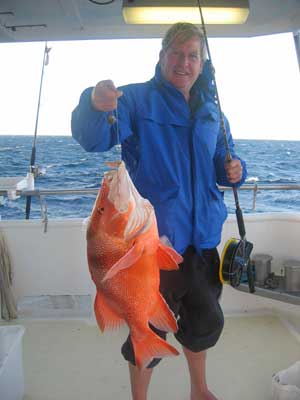How to Choose the Ultimate Fishing Rod
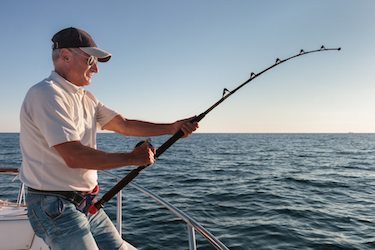
If you’re in the market for a new fishing rod, look no further. We’ve summarised the advantages and disadvantages here for each type of rod, their operating limits and useful features.
Click on the link to jump to the rod you’re interested in.
Carbon Fiber Rods
What are carbon fiber rods? These are advanced high-tech tubular rods constructed from various qualities of carbon fiber.
These rods are used in Europe to catch salmon and trout. The sport has been around since the 1800’s and was established as a gentry sport.
The rods vary in length from 10 feet to 13 feet and can be used to catch fish weighing as much as 200 lbs.
Pricing for carbon fiber rods starts around US$100 and can easily reach into the thousands of dollars.
Click here to find our more about the St. Croix Elite Salmon & Steelhead Spinning Rods
Ultralight Rods
These are high performance and affordable tackle.
An ultralight rod provides a more exciting fishing experience as the rod, in combination with the matching line and lures will give you greater sensitivity.
A small fish on a standard line offers little excitement, but on an ultralight rod, it feels like a lunker. And a lunker feels like a monster, offering a large challenge.
Ultralight rods are made from fiberglass allowing them to bend quickly when stressed. While rods are also made of boron and graphite, we recommend sticking with the fiberglass rods.
Boron and graphite are stiffer and can cause breaks with lines that are 1 or 2 lb test. However if you’re going after a lunker, they work well when used with the heavier light lines.
- Heavily fished areas provide a challenge for catching fish as they tend to shy away from larger and fast moving baits. In these circumstance the fish are more likely to strike at smaller baits and tackle.
Size varies greatly
Ultralight rods are designed to handle line test weights between 1 and 6 lbs. They can reach lengths as long as 6 ft or come in as short as 4 1/2 ft. There are some ultra-light rods that reach 11 ft long.
Match the reel to the rod you’ll be using and also match the line and lures.
So why not just outfit a standard spincasting rod with light line and tackle?
These are the 4 reasons for why choosing an ultralight rod will improve your odds
1.It’s all about balance. The rod, line and tackle all work together as a system. An ultralight rod is more sensitive to fish nibbles and strikes than a larger rod outfitted with smaller tackle.
2. Ultralight rods use ultralight lines and offer the benefit of being more translucent than standard weight line. However this is only an advantage in very clear water.
3. Cold fronts alter a fish’s eating habits much the same way that people can get headaches from low-pressure systems. Studies have proven that bass are more likely to strike at smaller baits and lures than regular tackle.
4. Also consider environments where the bait is small. These environments are best suited to fishing ultralight rods too.
Ultralight rods are used in combination with ultralight lures and provide many advantages over standard baitcasting and spincasting rods.
 Maintenance of ultralight rods
Maintenance of ultralight rods
The rod requires little maintenance other than an occasional wipe down. However the reel should be greased and cleaned from time to time. See our reel section for proper maintenance.
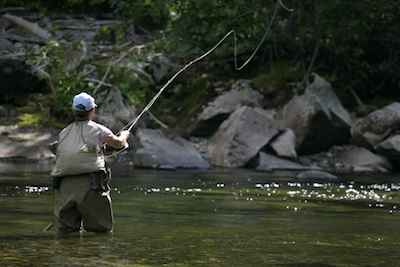 Fly Rod
Fly Rod
Fly rods are thin, flexible fishing rods that cast the line rather than using a weighted lure or bait. There’s no reel involved in casting.
Most often the bait is made up of fur, feathers or hair and is referred to as an artificial fly.
Modern fly rods are made from composite materials such as fiberglass, carbon graphite composites or graphite boron composites.
Lightweight rods are best used to cast small and light flies.
Typically a monofilament segment called a “leader” is tied to the fly line on one end and the fly on the other.
Rod size is specific to each fish species and even their size. As the line is cast, instead of using a weight the environmental conditions are important. Especially wind and water conditions.
How are fly rods made?
They’re created by laying down carbon fiber in complex patterns. Using this technique prevents the rod from distorting when stressed.
The greater the flex of the rod, the slower it is. This means that it cannot cast as far and is subject to the effects of the wind more than a faster rod.
- If fishing larger fish or those causing great stress, use a slower rod.
A fly rod has a single, large diameter line guide and uses a number of looped guides similar to a spincast rod, but acts to control a thick and heavy line. In order to prevent interference with casting movements, fly rods have a small butt extending below the fishing reel.
This video is worth watching for tips for good fly casting.
Trolling Rods
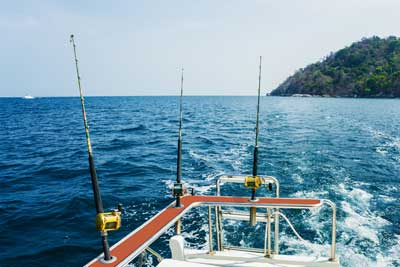
Tip: trolling for largemouth bass works well with a large topwater plug at least 50 ft behind the boat
How they work
Simply put, using a trolling rod enables you to cast out lures and baits from the side or back end of a boat. The motion of the boat pulls the bait through the water causing the same effect as if it were being reeled up.
Any good quality light and medium freshwater casting or spinning rod can be used for trolling and are adequate for most fishing. For example tailored rods aren’t needed for trolling standard lakes for bass, pike, trout and so on.
However if you’re wanting to step it up a notch manufacturers have developed a niche line of trolling rods that are built for long range fishing and designed for ocean anglers and the Great Lakes.
What do you look for in a trolling rod?
- The best trolling rods have a fast action
The 7 things to take into account when choosing should be
- matching the desired rod to the appropriate reel
- the rod stiffness
- the rod length
- whether you want 1 or 2 piece construction
- rod component materials
- what’s the weight of bait used
- the required line strength.
Other features to consider are a rod design that incorporates fast or limber tips coupled with sturdy butt sections.
Rod sensitivity is important for detecting bites from smaller game fish, yet at the same time the rod has enough strength to land larger fish.
Trolling rods are good for casting because the rod tip is more easily loaded for the whipping forces involved with casting.
Good quality trolling rods use blank through butt construction along with anodized inserts for line guides and sturdy reel seat attachment parts.
Baitcasting Rods and Spincasting Rods
What are the differences?
A spincaster uses a button to release the line whereas a baitcasting rod uses a bail to let out the line. They’re made from graphite or fiberglass.
The average spincast rod length is around 6 ft but can range between 5 and 8 1/2 ft in length.
Like many rods, guides keep the line in place. The shorter rods have as few as 5 guides and the longer rods having 8 guides. As you’d expect, the guides decrease in diameter towards the rod tip.
An important difference between spincasting and baitcasting, generally speaking, is that spinning rods aren’t as stiff as baitcasting rods and are meant for lighter lines and action.
Summarised, these are 3 basics you need to know
- Learning how to cast a spinning reel can be very easy.
- It’s also the most fragile and least versatile of the 3.
- I don’t recommend spincasting if you’re trying for fish bigger than 10 lbs
I highly recommend a spincasting rod for beginner anglers and kids because it’s simple to use.
Tip: The spinning rod and reel combo is the easiest of the 3 types of rod and reel combinations to master.
Spincasting reels hang beneath the rod while baitcasting reels are on top of the rod.
The placement of the rod makes little difference in catching fish, but it does make fishing more comfortable when fishing for extended periods.
Ok, with that said let’s get to it.
How to cast
1.Grip the rod with your right hand use your other hand to pull back the guard and hold the line with your right index finger. Some reels have a button to allow the line to be released.
2.If you’re standing, you’re best to place your weight over your right foot.
3.Aim the tip of your rod to your target with your arm extended in line with the rod.
4. Swing the rod forward but don’t release until the rod tip is pointing at 2 o’clock.
5. Release the line while you continue to swing the line. The weight of the lure will cause the rod to bend behind you so keep the tip high enough so you don’t snag.
Maintenance
The rod requires little maintenance other than an occasional wipe down. However, the reel should be greased and cleaned from time to time.
See our reel section for proper maintenance.
Telescopic Fishing Rod
 As the name implies, telescopic rods collapse and extend when needed. As some rods can reach 30ft, the ability to collapse the rod makes storage and transportation easy.
As the name implies, telescopic rods collapse and extend when needed. As some rods can reach 30ft, the ability to collapse the rod makes storage and transportation easy.
They’re constructed with graphite, fiberglass or composites materials. The guides are generally a special design to aid in making the end of each section stronger.
The given rule is
- the shorter the sections are
- the shorter they close
- the more guides they have
- the better the power curve is in them.
Maintenance
Take care of telescopic rods as you would with any other saltwater or freshwater rod. Your only concern with a telescopic rod is making sure it stores properly and is not susceptible to opening.
Twist it to loosen the section and then collapsing the rod closes it. Many rods, such as surf rods, use the telescopic method as transporting the full size rods can be difficult if you don’t have a ‘bus’ to drive your gear around.
 Tip for choosing the best telescopic fishing rod
Tip for choosing the best telescopic fishing rod
The more guides, the better it’s weight and stress distribution, which facilitates further casting and a more durable rod.![]()
Ice Fishing Rods
Ice rods make landing a 10lb lake trout a much more enjoyable experience because they’re constructed from both graphite and fiberglass with each offering advantages for specific situations.
Fiberglass rods are more durable and smoother at setting a hook as well as providing uniform curvature of the rod under stress.
Graphite rods are lighter and offer more sensitivity. All things being considered equal, an ice fishing rod will improve your chances of landing more fish than using traditional ice fishing tools.
Where available, use a winter grade line … it’s worth the money.
Maintenance
Don’t place your rod or line on the ice. Slush and ice can render both your rod and line useless. Monitor your line for coiling, which is caused by encounters with the cold air and water.
Size
Ice rods are about 1/2 to 1/3 the length of standard spincasting rods. This is necessary when fishing from inside a fish hut and gives you closer access to the ice hole. These rods can land lunkers as large as 20lbs, but choosing the right rod is important.
Tip: For large fish, use a heavy to a medium action rod with 12 to 17lb test line.
Surf Fishing Rods
Surf rods are used for casting from the beach to the breaking waves, or surf, to a distance of a hundred yards. These rods come in fiberglass and graphite.
Fiberglass rods are heavier than graphite and require a lot of stamina for long fishing excursions.
Graphite rods are lighter and offer greater control and response. However, there’s always a downside to every option.
Graphite rods are much more expensive than fiberglass rods and are brittle. We recommend if you’re going with a graphite rod, you should buy a quality rod.
Casting gear will cast further than spinning gear and spinning gear will allow your equipment to get wet. Huh? Now that I’ve confused you, let me explain.
What this really means is that while casting gear gives you greater casting distance, this is at the cost of being able to enter the water.
Spinning tackle is recommended, as there’s little difficulty in leading a fish with spinning gear.
What should you be looking for in surf rods?
- The number of guides ranges between 5 and 8 with many anglers preferring 6.
- The collector guide should be far enough away from the reel that the line doesn’t touch its top edge on casting.
- The tip guide should be as large as possible allowing a swivel to easily pass though the tip.
- Use a reel seat as it allows for easy removal and offers a sturdy set up.
Tip: Medium-fast rods perform well under windy conditions.
Size
- They’re constructed much like casting rods but with a long grip handle.
- Surf rods range in length from 10 to 14 ft. It’s their length that enables you to cast to 100 yards.
- While some rods come in at 9 ft or less, these don’t offer enough distance.
Medium-fast or medium-heavy rods are stiff in the shaft and bend mostly at the tip. While lighter rods have a uniform curve under tension and have a softer feel under use.
If cost is not an issue, buy a custom made rod. Note though, that you’ll need to have sufficient experience to known about the type and placement of the guides, seat, weight or length and even rod construction.
Best Saltwater Fishing Rods
The key to saltwater fishing is matching the rod to the target fish. And if you’re thinking of using a freshwater rod on the high seas, no matter how light-weight your catch, don’t.
Freshwater rods don’t offer enough corrosion resistance and are not capable of standing up to the saltwater environment.
Don’t use a heavy planer or deep-diving lure on a lightweight spinning rod. Using a light duty trolling rod in these conditions will lead to failure.
Tips for choosing the best saltwater rod
- The rod must be able to flex along its length and stay so under sustained pressure loads day after day and year after year
- The rod must also be resistant to corrosion along its metal surfaces due to salt exposure
- It must be able to stand up to solar and chemical degradation of its polymer composites.
Fiberglass rods provide greater durability. The reason is because they have more flexibility than that found in graphite rods.
Aluminium oxide guide inserts resist abrasion and corrosion while at the same time the double-bridge wrappings prevent them from folding or snapping under pressure.
Rod size and style depends upon 2 basic attributes:
- the type of fish
- the method used to catch the fish
Lightweight or heavyweight rod?
- Choose a lightweight rod that has graphite gimbles, with removable rubber butt caps as it helps prevent bruises where the rod butt can dig into your thigh.
- On the other hand, use a heavyweight rod when using pulling planers or speed lures and when chasing after the large game fish.
Large game fish require heavy-duty rods, which are constructed with reinforced tubular fiberglass blanks. The guides are double-bridged and made from stainless steel with the inserts made from aluminium oxide inserts.
The reel seats are made of graphite and the hoods are cushioned stainless steel.
Some heavy-duty rods have double-bridge guides that are chrome plated and made from stainless steel that extend through the handles providing extra strength.
Graphite gimbles, with removable rubber butt caps hold the rod securely against a horizontal pin in a fight belt or chair rod holder.
Maintenance of saltwater rods
While the saltwater rods are made from stronger materials and composites that protect against environmental hazards, wipe down your rod and reel after each outing.
Daily care for your gear can see your equipment last a lifetime.
If properly looked after saltwater fishing rods are relatively inexpensive compared to freshwater rods. The average price range for saltwater rods is between US$150 to $250, with some costing up to US$450 and as little as US$70. Their cost depends on their size, material composition and whether it’s designed for light or heavy-duty fishing.
Boat rods or trolling rods range in length from 6 1/2 ft to 8 1/2 ft in length while spinning rods range from 6 1/2 to 14 ft long.


